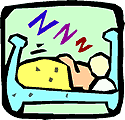Neuroscience For Kids
Too Much/Too Little Sleep Linked to Earlier Death
May 10, 2010
 People who sleep too much or too little may be at risk for an earlier
death! That's the conclusion of new research that examined data from
17 published studies that included 1,382,999 people.
People who sleep too much or too little may be at risk for an earlier
death! That's the conclusion of new research that examined data from
17 published studies that included 1,382,999 people.
Dr. Francesco Cappuccio and his colleagues from the University of
Warwick and University of Naples Medical School found that:

- Short sleepers (getting less than 7 hours of sleep each night) have a 12% greater risk of dying than people who sleep 7-8 hours each night.
- Long sleepers (getting more than 8 hours of sleep each night) have a 30% greater risk of dying than people who sleep 7-8 hours each night
The link between short and long sleeping times and an earlier death is limited by several factors in the design of the study. First, the data were gathered by looking at the results of previously published studies. The data really show an association between sleep times and early death; they do NOT say that too much or too little sleep CAUSE an earlier death.
 Second, the data are all self-reports. In other words,
people answered a survey regarding their own sleep times. It may be that
people do not accurately report how much they actually sleep. Also, the
quality of sleep and the number of naps were not reported. Because each
person was asked only once, it is unclear if sleep duration changed over
time. So, the amount of time each person slept too much or too little is
not known.
Second, the data are all self-reports. In other words,
people answered a survey regarding their own sleep times. It may be that
people do not accurately report how much they actually sleep. Also, the
quality of sleep and the number of naps were not reported. Because each
person was asked only once, it is unclear if sleep duration changed over
time. So, the amount of time each person slept too much or too little is
not known.
Third, health conditions that lead to early death may have affected sleep duration. For example, people with cardiovascular problems may have altered sleep patterns. Therefore, for some people, an underlying medical condition could be responsible for an earlier death and a longer or shorter sleep duration.
![]() The new research still points to a potential problem: abnormal sleep
duration may lead to an earlier death. Although it is not known
how sleep duration contributes to an earlier death, it is possible that
short sleeping leads to changes in hormone levels that affect metabolism,
appetite and cardiovascular fitness. Experiments to investigate these
variables should reveal more about the possible risks of too much and too
little sleep.
The new research still points to a potential problem: abnormal sleep
duration may lead to an earlier death. Although it is not known
how sleep duration contributes to an earlier death, it is possible that
short sleeping leads to changes in hormone levels that affect metabolism,
appetite and cardiovascular fitness. Experiments to investigate these
variables should reveal more about the possible risks of too much and too
little sleep.
References and more information:
- Cappuccio, F.P., D'Elia, L., Strazzullo, P. and Miller, M.A., Sleep duration and all-cause mortality: A systematic review and meta-analysis of prospective studies, Sleep, 33:585-592, 2010.
- Sleep - Neuroscience for Kids
- Sleep Affects Schoolwork - Neuroscience for Kids
Copyright © 1996-2010, Eric H. Chudler, University of Washington
